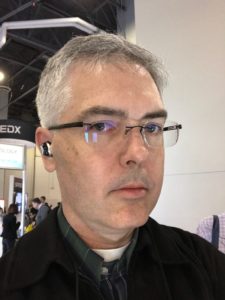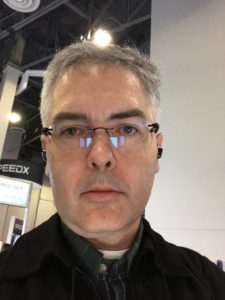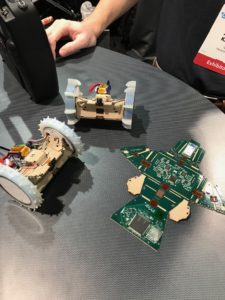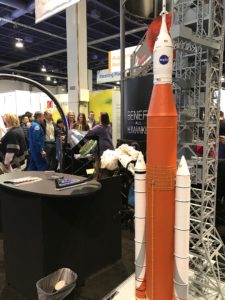I realize this is quite long for a blog post, and I apologize in advance for that. Save it for a time when you need some light reading…
I made my second consecutive trip to the annual Consumer Electronics Show (CES) this year in conjunction with the CES Government conference. As was the case last year, I saw a lot of really exciting technology. I can’t cover all of it, so I’ve narrowed it down once again to my personal Top 10. I hope you enjoy it!
I saw most of these marvels first-hand, but in the spirit of full transparency, I also consulted the list of CES Innovation Awards afterwards and found several surprises I had completely missed at the exhibit halls. That might seem negligent on my part but, if you’ve never been to CES, last year I spent almost 20 hours at the show and estimated I saw perhaps half of all there was to see. This year I was limited to about 12 hours; even though I felt I was smarter about my use of time, that’s not nearly enough time to see it all.
The tech in my Top 10 includes products that are innovative and, in most cases, their associated marketing was also innovative. It had to be – I understand there were more than 4,000 exhibitors at CES this year.
If your product doesn’t stand out, it’s going to be lost in the sea of “that’s cool” moments that come thousands of times per second at CES and then are gone forever.
Of course, not all marketing is good marketing. For example, in my opinion, any tech that requires barely dressed models to highlight it is probably not great tech – so keep moving. Sadly, some companies really failed in their marketing. One drone manufacturer had some very nice hardware to offer and they produced a classy, professional booklet showcasing those products on heavy paper with great photography. Inexplicably, however, they failed to have the copy translated by a native English-speaking person. So the text of the brochure contained wording that included: “Compact fuselage design of [drone model] not only can achieve the visual satisfy, but also the surprise to touch.” Really? Come on, man.
Last point before we get to the goods: I specifically avoided any “Best of CES” lists before the show since I didn’t want anyone else’s opinions to taint my own chance to discover cool things. I might change that principle next time in order to be even more efficient about where and how I spend time during the show.
To grossly paraphrase Ferris Bueller, “CES moves pretty fast, if you don’t hurry up and look around, you could miss it.”
10. mJoose
One of the more practical things I came across was the mJoose smartphone case. I am astonished at how often I still encounter dropped calls or poor signal quality even on the latest iPhone in major metropolitan areas. Just last week I was in a government building in downtown DC in an atrium with a glass ceiling and yet had no cellular data coverage. I drop calls while driving on the Interstate – that shouldn’t happen anymore.
The mJoose case tries to address these and several other smartphone issues. It promises signal boost of up to “100x” regardless of carrier or cell technology; a 2x battery boost; and shielding against 70% of the radiation coming off your phone (which seems like a really nice bonus). They also claim that the case charges your phone faster than a wall outlet (of course, you need to charge the battery inside the case). The downsides are that it inevitably adds a bit of bulk to the phone, and whether or not you consider it stylish is up to you.
mJoose is available today for iPhone 6/6s for $130 (discount code WHOAJOOSE gets you 15% off and free shipping through 3/31, by which time they expect the iPhone 7/7 Plus models to be available). Reviews posted on Amazon are mixed. https://mjoose.com/shop/mjoose-case-for-iphone-6-and-6s/
9. Link
Fasetto’s Link product is one I saw last year at CES, and it has grown up a lot (or shrunk?) in that time. Link is a very small (4 cubic inches) high capacity smart connected encrypted storage device that’s nearly indestructible. For CES 2017 they had a slick marketing campaign which included a spacious booth and a series of graphic novels to help dramatically tell their story. As an aside, I’m glad, in retrospect, I didn’t have time to read the one I picked up while at the show until almost two weeks later – it starts out with someone being diagnosed with the flu and then dying; I myself was diagnosed with the flu less than two days after CES ended, yikes!
Anyway, you can connect to Link via wi-fi, Bluetooth, or cellular. It supports up to 30 concurrent connections and can stream data out to up to 15 devices at a time. Capacities are available up to 2 TB. It’s not cheap – the top of the line runs $1,150 while the 256GB entry point is $350. But to have all your data always available on any device wherever you are and safely stored – this may be worth the cost of doing business for some people.
One feature worth pointing out – maybe – the graphic novel depicts a Siri/Alexa-style voice interface with Link. I don’t see that included in the online marketing so not sure if it’s a current feature – perhaps in conjunction with the smartphone app? – or a feature envisioned for the future.
The main question is probably why spend so much for this as opposed to just connecting to a cloud service? The answer seems to be that the cloud isn’t necessarily always available (see my recent connectivity issue noted in the mJoose write up above, not to mention the connectivity issues that are likely when you’re backpacking in the remote wilderness) and the performance between Link and your devices will almost always outpace any cloud connection. https://fasetto.link/
8. Maven Co-Pilot
There is a correlation between the frequency at which truck drivers check their mirrors and the incidence of traffic accidents in which they are involved. The Maven Co-Pilot is a smart Bluetooth headset and microphone for truck drivers which integrates with a mobile app to track driver head movements.
This seems to be one to watch – their management and advisors come from MIT, Amazon, FedEx Ground, and Uber. Plus, the company hails from the City of Champions – Pittsburgh, PA. http://www.mavenmachines.com
7. G-Hold
G-Hold is a device that attaches to the back of a tablet allowing you to hold it ergonomically. It turns out that crimping your tablet in your non-dominant hand is actually not good at all from an ergonomic standpoint. I ended up in physical therapy for a related matter a couple years ago (yes, embarrassingly, ‘smartphone elbow’ is a thing) so I understand why this is important, and G-Hold is a simple and effective solution. http://www.g-hold.com/
6. PicoBrew
For those who enjoy beer, if you like the idea of home brewing but are scared that you don’t have the time, space, or attention to detail necessary, PicoBrew might be a good alternative. The machine’s primary use case is to take pre-packaged ingredient blends for a variety of types of beer, ale, etc., properly mix and heat the solution, and provide a separate container for fermentation.
The PicoPaks as they are called cost about $23-30 and make 5 liters (about 1.3 gallons or the equivalent of about 14 12-ounce bottles). So the point isn’t to save money, but to make it yourself and perhaps to enjoy the potential health benefits of unpasteurized, unfiltered beer, all without as much of the effort of traditional home brewing. It’s important to note, however, that PicoBrew can’t defy physical laws – fermentation still takes time, 7-10 days on average. So this is not like a “beer Keurig” producing instant beverages. There are some other caveats having to do with getting the beer ‘racked’ and carbonating it which you’ll want to read about on the web site.
In addition, there are a couple of alternative uses for PicoBrew. First, you can develop your own ingredient blend using an online tool from the PicoBrew people. They will then produce PicoPaks for you and send them out. Currently you cannot just go down to your local homebrew store and buy your own ingredients (although they offer a bigger home brew machine called Zymatic that lets you do just that). Second, the PicoBrew can function as a small sous-vide machine up to 205 degrees.
The reviews for PicoBrew have been mixed. Some people think it takes too much of the fun and customization out of the homebrewing process. Others feel that it’s a great tool for streamlining that process. PicoBrew is priced at $799; they had a $200 off promo in conjunction with CES but that has ended. http://www.picobrew.com
5. JamEasy
Resulting from an innovation challenge sponsored by Samsung, JamEasy is a small device that clips on to a musical instrument – in their booth demo they were using violins. The device serves a couple of purposes. 1) It helps tune the instrument; 2) in conjunction with some software, it will display sheet music on a tablet, move the music automatically as the performer plays, and highlight correctly/incorrectly played notes along the way. They consider it gamification of sheet music. With three string instrument players in my house, this would be a big hit and reduce the need for as many private lessons. It’s available now, fully compatible with Android (again, it was sponsored by Samsung) and partially compatible with iOS. http://www.jameasy.com
4. BionicBird
CES had a lot of drones again this year, including such things as fishing drones (in fact two different ones) and a drone shaped like an egg. To me, BionicBIrd was the most intriguing of them all. Rather than the common rotor-based design, the bionic bird mimics bird flight. And it’s relatively affordable at roughly $85, based on the current conversion rate with the Euro. You just have to watch the videos on the web site – simply amazing. http://www.mybionicbird.com/boutique/en/full-packs/8-bionic-bird.html
3. Audio innovations
Ok, I’m abusing the Top 10 limit here by combining three interesting yet unrelated audio products:
3a. Westone
Have you ever listened to $1,500 earphones? Neither had I until visiting the hi-fi audio showcase at CES 2017. While there, not only did I sample the Westone W80 in-ear monitors, but I had them correctly fit into my ears by none other than the co-inventors of in-ear monitor technology, the Cartwright brothers.
Westone originally built earphones for UltimateEars and Shure beginning 30 years ago. The current Westone units are made such that they don’t need to be deeply inserted into the ear canal, unlike other IEMs, which should make them more comfortable across a wider range of ear sizes and shapes (which matters greatly when it comes to IEM experience and sound quality).
How did the W80 sound? With a total of 16 drivers powered by a high quality audio amplifier during my demo, the John Coltrane music I sampled nearly brought tears to my eyes it was so beautifully detailed. Switching over to the “el cheapo” $500 W40 was a noticeable drop down.
I’m not sure I could justify the W80s (or the W40s for that matter) myself. For one thing, you need to have very high quality recordings and audio players to enjoy the sound, since the better the earphones, the better they transmit all the details of the source – good and bad. I stepped into a portable audio shop in the LAS airport while waiting for my flight and was surprised to see no fewer than three (3) sets of W80s right there on the shelf at full list price, so someone must be buying them. http://www.westone.com
3b. Snugs
Snugs offers custom fit silicon earphone tips. Why does this matter? As noted in the write up on Westone above, the sound quality achieved by in-ear monitor style earbuds depends heavily on achieving a good ‘seal’ inside your ear canal. It turns out, ear canals come in many shapes and sizes. A custom solution allows for a perfectly tailored fit. As I was told, typically, custom-fit earphones are made using a material like clay that’s inserted into the ear to make a mold for rubber tips. The Snugs solution instead uses a handheld scanner to map each person’s ear canal in three dimensions, then feeds that scanner data to a machine that 3D prints tips made of silicon.
This approach costs the consumer about $200 compared to about $800 for traditional customs. If you have nice earphones but are having trouble getting them to sound as good as they should, this could be money well spent. http://www.snugsearphones.co.uk
3c. NuHeara IQBuds and Doppler Labs Here One

 IQbuds is an offering from NuHeara in a class of products I am particularly interested in – so much so that it was on my “must see” (hear) list for CES 2017.
IQbuds is an offering from NuHeara in a class of products I am particularly interested in – so much so that it was on my “must see” (hear) list for CES 2017.
I heard one of their competitors, called Here Active Listening last year on the way home from CES. One of their marketing folks sat beside me on the plane and she let me sample a prototype. The idea with these products is that they are wireless ear buds that shape the sound around you in ways that help you better hear what you want. E.g., on that plane ride, Here Active Listening was able to almost completely block the sound of the plane engines and other ambient noise while highlighting the voice of the lady speaking to me. It was almost as if she and I were suddenly the only ones on the plane. I immediately sensed that this is the solution to the problem I increasingly encounter as a middle aged male – inability to hear my colleagues at a dinner meeting in a loud restaurant or ballroom.
I have been patiently waiting for Here to evolve their product and roll it out. To be honest, I have felt at times like it’s mainly a social experiment to see how long people will wait for a product that never materializes. If I hadn’t had that experience on the plane last year, I would probably have given up by now. Interestingly, Here (Doppler Labs) showed off their new Here One product to the media at CES 2017, but they didn’t have a booth for showing it to the general public. (Boo hiss!)
NuHeara, on the other hand, was happy to demo their product. I was privileged to have CEO Justin Miller personally assist me in my demo and, given my experience with the competition, he seemed eager to show off his alternative. He noted that the airplane demo I experienced with Here Active Listening is actually a fairly easy problem to address. Noise in a crowded room – say an exhibit hall at the largest technology trade show in the world – is harder. This class of products are more than fancy ear buds – they are essentially on-ear computers with a lot of potential applications.
After identifying the right size ear cushions for my ears, he helped me properly insert the IQbuds. They immediately began processing the outside sound. That is, natural outside sound is mostly isolated, instead you hear that sound after it has been processed by the ear buds and their software. To me, the digital processing was noticeable as the sound had a ‘tin can’ effect to my ears. Even so, once he enabled the filters to focus on conversation, I was much more easily able to discern his voice even as he walked 360 degrees around me and kept talking. There is a slight delay in the sound processing. I found it to be just slightly noticeable, like when your tv has an HDMI sync problem and lips move out of alignment with the sound. It was very slight and I’m sure I would get used to it.
When he switched on some music, I was blown away. Best sounding music on wireless earphones I have ever heard. Drawbacks I see are the size – there is no hiding the fact you are wearing these things. In a typical music-listening setting while sitting alone or on a bus/plane, etc. no big deal. When sitting across the table at a business dinner – I don’t know. NuHeara goes out of their way to make sure they don’t position IQbuds as a hearing aid. That would require FDA regulatory approval. But I can see these potentially being a greater help to some people than traditional digital hearing aids.
The price point for Here One, IQbuds, and a few other similar devices is about $300 (NuHeara is running a $40 discount through Feb. 15 with promo code ‘Save40’ at checkout). That lines up well with higher end mainstream earphones like the Beats line sold by Apple but more than Apple’s own wireless EarPods (which lack many of the capabilities of IQBuds and Here One).
As is the case with Doppler Labs, the NuHeara product comes in a case that also serves as a mobile recharging station. NuHeara claims 32 hours of use per charge unless you are streaming Bluetooth audio in which case you should expect 16 hours per charge. In all cases, some downsides will be sound quality of the internal microphone during phone calls since they are in your ear and so far away from your mouth, not to mention that it seems all too easy to lose one or both earbuds.
One big win for NuHeara – as of today, they are actually shipping their product. I look forward to trying the Here One for comparison when it comes out soon(?). See NuHeara at http://www.nuheara.com/ and Here One at https://hereplus.me/.
2. NuCalm
I found this one especially intriguing. It’s called NuCalm. It’s a system for applying neuroscience to physical recovery and stress management. The idea is that through their system, you can obtain two hours’ worth of deep REM sleep/recovery in 20 minutes. The main techy component of the system is a headband that does the neuro-stimulation, but other components include earphones for alpha and beta wave sound transmission, a cream and a pill used for adrenaline blocking, as well as an eye mask.
The Chicago Blackhawks NHL team is one of their big customers (in fact everyone manning the booth was wearing a Blackhawks jersey, which nearly made me keep walking, but then I thought about the freshly engraved names of the 2016 Pittsburgh Penguins on the Stanley Cup and I felt better).
The main use cases they described are:
- People who don’t get enough natural sleep, whether in quantity or quality or both, for any number of reasons. In other words, everyone.
- People who need to feel refreshed ahead of certain tasks (sports performance, executive performance, etc.)
- People who are having stress/anxiety problems.
- Dentistry patients (a subset of the group above – a quick Google shows this is very popular among dentists seeking to offer a drug-free ‘sedation’ solution)
The system normally sells for $5,000 plus consumables (the cream and pills); they were offering a CES promotional price of $3K.
I did not get the chance to try it myself – the line was too long and I had places to be (as an aside, the only longer line I saw was at the Starbucks inside the LVCC and it occurred to me the people on both lines were seeking the same thing) – but chatting with the people who came out from the demo, they said they felt better. Snake oil or revolutionary? For a fee, you can find out… or maybe just try visiting one of the dentists who offer it. More info here: http://www.nucalm.com/
Now, as an example of how much information overload exists at CES, I completely missed the new consumer grade product offering they rolled out. The ReNu uses the same tech but costs much less than the full blown NuCalm ($800) that’s evidently more intended for the professional market (dentists, psychologists). Engadget covered it here: https://www.engadget.com/2017/01/03/renu-is-an-acoustic-kit-that-sends-calming-vibes-to-your-brain/
1. NASA

 Yes, my Number 1 is not a product company; then again, it is in a way, and one that all of us U.S. taxpayers own a little piece of.
Yes, my Number 1 is not a product company; then again, it is in a way, and one that all of us U.S. taxpayers own a little piece of.
Obviously, NASA has nothing to sell unless you consider their need to market the necessity of their mission to remain in the federal budget a sales campaign – and I suppose it is. That said, they had what I felt was just about the most interesting booth at all of CES. The young scientists they had on hand to present NASA’s latest research were extremely knowledgeable and excited about the work. They even brought Don Thomas back, a former Space Shuttle astronaut who I met last year.
NASA is getting ready for the next trip around the moon in 2018 as part of the Orion program whose ultimate goal is to send a manned mission to Mars in the 2030s. One exhibit focused on the delivery system for the Orion module.
At another exhibit, a scientist from JPL showed off ‘origami’ folding mini-rovers. These two-wheeled land drones can dynamically fold and bend to navigate a wide range of terrains. It was very easy to see that this was an innovation that could also be applied on Planet Earth in a number of ways.
That’s a wrap!
So there it is, my list of Top 10 things I saw this year at CES. After two trips in a row, yes there are some things that didn’t change much from one year to the next, but much, much more that did. I already can’t wait for CES 2018!


